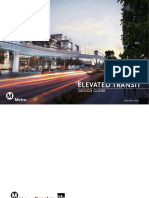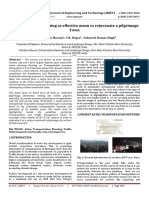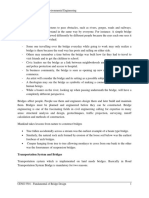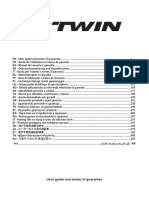Ceng55-Lectures (1-3)
Ceng55-Lectures (1-3)
Uploaded by
Lorcie CruzCopyright:
Available Formats
Ceng55-Lectures (1-3)
Ceng55-Lectures (1-3)
Uploaded by
Lorcie CruzOriginal Title
Copyright
Available Formats
Share this document
Did you find this document useful?
Is this content inappropriate?
Copyright:
Available Formats
Ceng55-Lectures (1-3)
Ceng55-Lectures (1-3)
Uploaded by
Lorcie CruzCopyright:
Available Formats
HIGHWAY AND RAILROAD ENGINEERING
CENG55 - Lecture 01 - Introduction
TRANSPORT So, why are highways so important?
Is a science that concerns with the efficient Highways are vitally important to a country’s
movement of people and goods that is economic development. The construction of a high
undertaken to accomplish objectives to complete quality road network directly increases a nation’s
tasks that require transfer from one location to economic output by reducing journey times and costs,
another. making a region more attractive economically. The
actual construction process will have the added effect
TRANSPORTATION ENGINEERING of stimulating the construction market.
Is concerned with the application of scientific
principles to the planning, design, operation, and 2. TRANSPORTATION SYSTEMS
management of transportation system. It is a sub-
specialty of civil engineering. However, it is
inherently multidisciplinary overlapping diverse
fields as economics, psychology, geography, city
planning, public administration, political science,
industrial, and electrical engineering.
1. IMPORTANCE OF TRANSPORTATION
Tapping natural resources and markets and
maintaining a competitive edge over other regions
and nations are linked closely to the quality of the
transportation system. The speed, cost, and
capacity of available transportation have a significant
impact on the economic vitality of an area and the
ability to make maximum use of its natural
resources. Examination of most developed and
industrialized societies indicates that they have been
noted for high-quality transportation systems and
services. Without the ability to transport manufactured
goods and raw materials and without technical know-
how, a country is unable to maximize the comparative
advantage it may have in the form of natural or
human resources. Countries that lack an abundance
of natural resources rely heavily on transportation in
order to import raw materials and export
manufactured products.
LESLIE ANN C. RAVELO
BSCE 2-1
HIGHWAY AND RAILROAD ENGINEERING
CENG55 - Lecture 01 - Introduction
3. CHARACTERS OR ROAD TRANSPORT
Road transport is one of the most common
mode of transport. Roads in the form of trackways,
human pathways etc. were used even from the pre-
historic times. Since then, many experiments were
going on to make the riding safe and comfort. Thus,
road construction became an inseparable part of
many civilizations and empires.
1. Roads are used by various types of road vehicles
like cars, buses, truck, two and three wheeled
automobiles, pedal cycles and animal drawn vehicles.
But railway tracks are used only by rail locomotives
and wagons, waterways are used only by ships and
boats.
2. Road transport requires a relatively small
investment for the government. Motor vehicles are
much cheaper than other carriers like rail locomotives
and wagons, water and air carriers. Construction and
maintenance of road is also cheaper than that of
railway tracks, docks, harbors and airports.
3. Road transport offers a complete freedom to road
users to transfer the vehicle from one lane to another
and from one road to another according to need and
convenience. This flexibility of changes in location,
direction, speed, and timing of travel is not available
in other modes of transport.
4. In particular for short distances travel, road
transport saves time.
5. Speed of movement is directly related with the
severity of accident. The road safety decreases with
increasing dispersion in speed. Road transport is
subjected to a high degree of accidents due to
flexibility of movements offered to the road users.
6. Road transport is the only means of transport that
offers itself to the whole community alike.
LESLIE ANN C. RAVELO
BSCE 2-1
HIGHWAY AND RAILROAD ENGINEERING
CENG55 - Lecture 02 - Highway and Its Development
ROAD or PAVEMENT THE MAIN FEATURES OF THE ROMANS ROADS :
Pavement or Road is an open, generally public They were built straight regardless of gradients.
way for the passage of vehicles, people, and They were built after the soft soil was removed and
animals. a hard stratum was reached.
The total thickness of the construction was as high
HISTORICAL DEVELOPMENT OF ROAD as 0.75 to 1.2 meters at some places, even though
CONSTRUCTION the magnitude of wheel loads of animal drawn
vehicles was very low.
The wearing course consisted of dresses large
stone-blocks set in lime mortar.
CLASSIFICATION OF ROADS BASED ON:
The general appearance of such a metalled road and
footway is shown in an existing street of Pompeii. SPEED AND ACCESSIBILITY
1. Native earth - leveled and, if necessary, rammed Freeways/Expressways
tight. Highways
2. Statumen - stones of a size to fill the hand. Arterials
3. Audits - rubble or concrete of broken stones and Local Streets
lime. Collector Roads
4. Nucleus - kernel or bedding of fine cement made of
pounded potshards and lime. MATERIALS USED
5. Dorsum or agger viae - the elliptical surface or Earthen Roads
crown of the road (media stratae eminentia) made of Gravel Roads
polygonal blocks of silex (basaltic lava) or rectangular Water bound Macadam (WBM)
blocks of saxum quadratum (travertine, peperino, or Bituminous Roads
other stone of the country). The upper surface was Cement Concrete Roads
designed to cast off rain or water like the shell of a
tortoise. The lower surfaces of the separate stones, USAGE
here shown as flat, were sometimes cut to a point or All-weather Roads
edge in order to grasp the nucleus, or next layer, more Fair-weather Roads
firmly.
6. Crepido, margo or semita - raised footway, or CARRIAGEWAY
sidewalk, on each side of the via. Paved Roads
7. Umbones or edge-stones. Unpaved Roads
RIGIDITY
Hilly Roads
Plain Area Roads
LESLIE ANN C. RAVELO
BSCE 2-1
HIGHWAY AND RAILROAD ENGINEERING
CENG55 - Lecture 02 - Highway and Its Development
ECONOMY
Low-cost Roads
Medium-cost Roads
High-cost Roads
TRAFFIC VOLUME
Low traffic Roads
Medium traffic Roads
High traffic Roads
TRAFFIC TYPES
Cycle tracks
Pedestrian tracks
Motorways
ROAD PATTERNS RADIAL PATTERN OR STAR PATTERN:
There are different types of road pattern used in In this road pattern, the network of roads is in the
highways, when the road is constructed in a form of circles originating from the center of the
pattern like rectangular pattern, radial pattern, area.
hexagonal pattern, etc. for proper management of It is a mixture of radial and block patterns wherein
traffic it is called a road pattern. a radial network of roads exits from the middle with
Roadways are very essential in the development of a block pattern network of roads in between the
the settlements in a city. radial main roads.
However, recent development does not give
important to the study of road patterns, giving rise
to roads that are not interconnected.
RADIAL AND GRID PATTERN:
The radial and grid pattern is a combination of
radial and grid patterns through which the radial
network of roads originates externally from the
RECTANGULAR PATTERN OR GRID PATTERN: center.
This type of pattern is a scheme where the streets The main radial roads are interconnected by
and roads are moving perpendicular to each other offering a grid pattern between the principal roads.
in the form of a grid or block thus forming a block The radial and the circular pattern is the road
or grid pattern. pattern in which the main roads originate from a
central point and connected together by narrow
roads that radiate outward.
LESLIE ANN C. RAVELO
BSCE 2-1
HIGHWAY AND RAILROAD ENGINEERING
CENG55 - Lecture 02 - Highway and Its Development
TRAFFIC OR ROAD USE STUDIES
Traffic volume in vehicles per day, annual average
daily traffic, peak and design hourly traffic volume
Origin and destination studies
Traffic flow patterns
Mass transportation facilities
Accidents, their cost analysis and causes
Future trend and growth in traffic volume and
goods traffic, trend in traffic pattern
Growth of passenger trips and the trend in the
choice of modes
ENGINEERING STUDIES
HEXAGONAL ROAD PATTERN: Topographic Surveys
This pattern is a network of roads that grow is such Soil Surveys
manner in different directions forming hexagons. Location and Classification of Existing Roads
Estimation of possible developments in all aspects
due to the proposed highway development
MINIMUM TRAVEL ROAD PATTERN:
In this road pattern, the town is contented by sector Road life studies
centers, suburban facilities and neighborhood Traffic studies, Origin and Destination studies
centers by highway which required minimum time Special problems in drainage, construction and
reach the city center. maintenance of roads
PLANNING SURVEYS
Highway Planning Phase includes:
Assessment of road length requirement for an area
(it may be a district, state or the whole country)
Preparation of master plan showing the phasing of
plan in annual and or five year plans.
ECONOMIC STUDIES
Population and its distribution in each village, town
or other locality with the area classified in groups.
Trend in population growth
Agricultural and industrial products and their listing
in classified groups, area wise.
Industrial and agricultural development and future
trends
Existing facilities with regard to communication,
recreation and education etc.
Per capita income.
FINANCIAL STUDIES
Sources of income and estimated revenue from
taxation on road transport
Living standards
Resources at local level, toll taxes, vehicle
registration and fines.
Future trends in financial aspects
LESLIE ANN C. RAVELO
BSCE 2-1
HIGHWAY AND RAILROAD ENGINEERING
CENG55 - Lecture 03 - Highway Alignment and Surveys
HIGHWAY ALIGNMENT SAFE
The position or the layout of the center line of the Should be safe enough for construction and
highway on the ground is called the alignment. maintenance from the view point of stability.
The Horizontal Alignment includes the straight path, ECONOMICAL
the horizontal deviations, and curves. The total cost including initial cost,
Changes in gradient and vertical curves are covered maintenance cost and vehicle operation cost
under vertical alignment of roads. is lowest.
FACTORS CONTROLLING ALIGNMENT
OBLIGATORY POINTS
There are control points governing the
alignment of the highways. These control
points may be divided broadly into two
categories:
Points through which the alignment is to
pass.
Points through which the alignment
should not pass.
TRAFFIC
The alignment should suit traffic requirements.
Origin and destination should be carried out in
the area and the desire lines be drawn
DISADVANTAGES OF IMPROPER ALIGNMENT
Increase in construction cost showing the trend of traffic flow. The new road
Increase in maintenance cost to be aligned should keep in view the desired
Increase in vehicle operation cost lines, traffic flow patterns and future trends.
Increase in accident rate
BASIC REQUIREMENTS OF AN IDEAL
ALIGNMENT BETWEEN TWO TERMINAL
STATIONS:
SHORT
It is desirable to have a short (or shortest)
alignment between two terminal stations.
EASY
Should be such it is easy to construct and
maintain the road with minimum problems.
LESLIE ANN C. RAVELO
BSCE 2-1
HIGHWAY AND RAILROAD ENGINEERING
CENG55 - Lecture 03 - Highway Alignment and Surveys
GEOMETRIC DESIGN The probable alignment can be located on the
Gradient map from the following details available on the
Radius of curve map.
Sight distance a) Alignment avoiding valleys, ponds or lakes
As far as possible, the gradient should be flat b) When the road has to cross a row of hills,
and less than the ruling or design gradient. possibility of crossing through a mountain
pass
ECONOMICS c) Approximate location of bridge site for
In working out the economics, the initial cost, crossing rivers, avoiding bend of the river, if
the cost of maintenance and vehicle operation any.
should be taken into account. d) When a road is to be connected between two
stations, one of the top and the other on the
OTHER CONSIDERATIONS foot of the hill, then alternate routes can be
Drainage considerations, suggested keeping in view the permissible
Hydrological factors gradient.
Political considerations
Monotony
ENGINEERING SURVEYS
THE STAGES OF ENGINEERING SURVEYS:
MAP STUDY
If the topographic map of the area is available,
it is possible to suggest the likely routes of the
route.
The main features like rivers, hills, valleys etc.
RECONNAISSANCE
Examine the general character of the area for
deciding the most feasible routes for detailed
studies.
A field survey party may inspect a fairly broad
stretch of land along the proposed alternative
routes of the map in the field.
LESLIE ANN C. RAVELO
BSCE 2-1
HIGHWAY AND RAILROAD ENGINEERING
CENG55 - Lecture 03 - Highway Alignment and Surveys
Barometer Procedure of conventional methods of preliminary
survey:
a. Primary traverse – The length of the center
line should be measured by using very good
and accurate methods.
b. Topographical features – All geographical and
other man-made features along the traverse
From the details collected during are surveyed and plotted.
reconnaissance, the alignment proposed after c. Levelling work – Carried out side-by-side to
study may be altered or even changed give the center line profiles and typical cross-
completely. sections.
As a result of the reconnaissance a few d. Drainage studies and Hydrological data–
alternate alignments may be chosen for study estimate type, number and approximate size
based on practical considerations observed at of cross drainage structures.
the site. e. Soil survey – Helps in working out details of
earthwork, slopes, suitability of materials,
PRELIMINARY SURVEYS subsoil and surface drainage requirement and
To survey the various alternate alignments type and approximate thickness requirements.
proposed after the reconnaissance and to f. Material Survey – for naturally occurring
collect all the necessary physical information materials like stone aggregates, fine
and details of topography, drainage and soil. aggregates, identification of suitable quarries.
To compare the different proposals in view of Availability of manufactured materials like
the requirements of a good alignment. cement.
To estimate quantity of earth work materials g. Traffic survey – Forms the basis for deciding
and other construction aspects and to workout the number of traffic lanes and roadway width,
the cost of alternate proposals. pavement design and economic analysis of
To finalize the best alignment from all highway project.
considerations. h. Determination of final center line – after
Preliminary Survey Methods: completing the preliminary surveys and
Conventional Approach – a survey party conducting the comparative studies of
carries out surveys using the required alternative alignments, the final center line of
field equipment, taking measurements, the road is to be decided in the office before
collecting topographical and other data the final location survey.
and carrying out soil survey.
Modern rapid approach – aerial survey
taking the required aerial photographs
and by photogrammetric methods and
photo-interpretation techniques for
obtaining the necessary topographic and
other maps including details of soil and
geology.
LESLIE ANN C. RAVELO
BSCE 2-1
HIGHWAY AND RAILROAD ENGINEERING
CENG55 - Lecture 03 - Highway Alignment and Surveys
Procedure of Aerial photographic survey:
a. Taking aerial photographs of the strips of land
to be surveyed with the required longitudinal
and lateral overlaps. Vertical photographs are
necessary for the preparation of mosaics.
b. The photographs are examined under
stereoscopes and control points are selected
for establishing the traverses of the alternate
proposals. The control points are located on
the maps.
c. Using stereo-pair observations, the spot levels
and subsequently contour lines may be
obtained. Also from the stereo pairs the
topographical details may be noted down on
the maps.
d. Photo-interpretation methods are used to
assess the geological features, soil conditions,
drainage requirements etc.
FINAL LOCATION AND DETAILED SURVEYS
The alignment finalized at the design office
after the preliminary survey is to be first
located on the field by establishing the center
line.
Next detailed survey should be carried out for
collecting the information necessary for the
preparation of plans and construction details
for the highway project.
Location - The center line of the road finalized
in the drawings is to be translated on the
ground during the location survey.
Detailed Survey - The date during the
detailed survey should be elaborate and
complete for preparing detailed plans, design
and estimates of the project.
LESLIE ANN C. RAVELO
BSCE 2-1
You might also like
- Bridge Engineering Lecture Note PDFDocument71 pagesBridge Engineering Lecture Note PDFephrem74% (42)
- 1994 Jeep Cherokee Owners Manual PDFDocument2 pages1994 Jeep Cherokee Owners Manual PDFRain Song20% (5)
- Transportation Engineering NotesDocument19 pagesTransportation Engineering NotesMahesh Ramteke100% (1)
- Unit 1 (INTRODUCTION OF HIGHWAY ENGINEERING) - JLN RayaDocument21 pagesUnit 1 (INTRODUCTION OF HIGHWAY ENGINEERING) - JLN RayaZara Nabilah83% (6)
- Filming PermitDocument1 pageFilming Permitleannematthews12345No ratings yet
- Road Users GuideDocument96 pagesRoad Users GuideOmer KhayyamNo ratings yet
- History of Road1Document10 pagesHistory of Road1Heart HackerNo ratings yet
- Roads and HighwaysDocument3 pagesRoads and HighwaysJosiah AntoninoNo ratings yet
- Unit-V 1Document9 pagesUnit-V 1chaitanyacharan07No ratings yet
- GROUP 2 HighwayDocument12 pagesGROUP 2 Highway201240290No ratings yet
- Fundamentals of Bridge Design Note (Repaired)Document73 pagesFundamentals of Bridge Design Note (Repaired)Awoke Aschale80% (5)
- He NotesDocument207 pagesHe NotesPG - ARMY f fNo ratings yet
- CE43-A/B Principles of Transportation: Instructor: Engr. Giovanni B. Narciso, M'ENG. (CE), Mat'l. Eng'rDocument55 pagesCE43-A/B Principles of Transportation: Instructor: Engr. Giovanni B. Narciso, M'ENG. (CE), Mat'l. Eng'rMoira Elizabeth SyNo ratings yet
- Week 2 - Highway Development and PlanningDocument10 pagesWeek 2 - Highway Development and PlanningADRIAN FRAGATANo ratings yet
- 01.2 ENSTP - 2019 History of RaodsDocument11 pages01.2 ENSTP - 2019 History of RaodsSouaibou BoubakariNo ratings yet
- Highway and Raildroad EngineeringDocument10 pagesHighway and Raildroad EngineeringJannila PaulinoNo ratings yet
- Group 2 HighwayDocument51 pagesGroup 2 Highway201240290No ratings yet
- Elevated Transit GUIDEDocument58 pagesElevated Transit GUIDEatbactadNo ratings yet
- Module 2 Highway Development and Planning Reviewer Partialy FinishedDocument8 pagesModule 2 Highway Development and Planning Reviewer Partialy FinisheddenzzaidNo ratings yet
- Fundamental of Bridge Design UE 452 - Design of RC Structures II, 342Document71 pagesFundamental of Bridge Design UE 452 - Design of RC Structures II, 342Saranyaleo100% (1)
- Shiv Ram Meena PPT PWD-1Document17 pagesShiv Ram Meena PPT PWD-1Mitesh Saini100% (2)
- Highway HistoryDocument3 pagesHighway HistoryCHARLES MAINANo ratings yet
- Transportation Planning As Effective MeaDocument7 pagesTransportation Planning As Effective MeaRwitika TarafderNo ratings yet
- CENG 55 Lecture 02 Highway and Its DevelopmentDocument7 pagesCENG 55 Lecture 02 Highway and Its DevelopmentKenzo RodeoNo ratings yet
- Presentation562 New2Document43 pagesPresentation562 New2Harshal KhalodeNo ratings yet
- Handout g1 (Bsce-3b)Document7 pagesHandout g1 (Bsce-3b)flortwaiinNo ratings yet
- Roads-By OKIRORDocument100 pagesRoads-By OKIRORMusiime AlvinNo ratings yet
- BridgeDocument58 pagesBridgeIyœ Møsisæ100% (2)
- Ch-1 _Notes_Planning & AlignmentDocument30 pagesCh-1 _Notes_Planning & Alignmentbiharisharma602No ratings yet
- 01 408 - Introduction To Highway and Railroad EngineeringDocument13 pages01 408 - Introduction To Highway and Railroad EngineeringKenneth FajardoNo ratings yet
- Highway and Railroad EngineeringDocument5 pagesHighway and Railroad EngineeringRian BernanteNo ratings yet
- 2.0 Highway Development and PlanningDocument35 pages2.0 Highway Development and PlanningPearl Mae AngusNo ratings yet
- Unit+1 +Highway+&+Railroad+Engineering+PDFDocument167 pagesUnit+1 +Highway+&+Railroad+Engineering+PDFDexter SerranoNo ratings yet
- Unit I Highway Planning and AlignmentDocument29 pagesUnit I Highway Planning and AlignmentKandasamy AsohanNo ratings yet
- Functional Classification of HighwaysDocument7 pagesFunctional Classification of HighwaysJester AbucayNo ratings yet
- 12 Tunnels and GeologyDocument7 pages12 Tunnels and Geology22100204No ratings yet
- Chapter 1 - Introduction To Highway EngineeringDocument63 pagesChapter 1 - Introduction To Highway EngineeringSAYA HENSEM100% (2)
- 2017 Highway EngineeringDocument212 pages2017 Highway EngineeringChristopher Joshua MartinezNo ratings yet
- Highway Engineering 1 PDF FreeDocument212 pagesHighway Engineering 1 PDF FreeMarjon MamangunNo ratings yet
- Raod Alignment & Setting OutDocument43 pagesRaod Alignment & Setting OutJEAN DE DIEU MUVARANo ratings yet
- CE315- REVIEWERDocument27 pagesCE315- REVIEWEREll John Dato-onNo ratings yet
- CENG 5501, Bridge Eng'g PDFDocument73 pagesCENG 5501, Bridge Eng'g PDFtewele brhane100% (1)
- Hre Midterm Reviewer l1 l3 OnlyDocument13 pagesHre Midterm Reviewer l1 l3 OnlyRadie ArnaldoNo ratings yet
- Group 1-TranspoDocument11 pagesGroup 1-TranspoHals MataNo ratings yet
- Part A Te 2Document4 pagesPart A Te 2muhammed mundhirNo ratings yet
- Modes of TransportDocument8 pagesModes of TransportTabrez CommunicationNo ratings yet
- Civil V Transportation Engineering 1 U2Document11 pagesCivil V Transportation Engineering 1 U2Abhishek nNo ratings yet
- Act 2 HreDocument2 pagesAct 2 HreZeina JelaineNo ratings yet
- Geometric Design of HighwayDocument108 pagesGeometric Design of Highwaysamiasefa27No ratings yet
- Cet 206 - Module 1Document53 pagesCet 206 - Module 1hakih95814No ratings yet
- Road Survey NotesDocument5 pagesRoad Survey NotesAiswariya MeenuNo ratings yet
- CHAPTER 1 IntroductionDocument12 pagesCHAPTER 1 IntroductionMul'ataa Vission AbdiisaaNo ratings yet
- Designing The Highway: Reported By: Juvy Ann Acabo Czarina AguilarDocument12 pagesDesigning The Highway: Reported By: Juvy Ann Acabo Czarina AguilarCzarinaCanarAguilarNo ratings yet
- Group No. 1 TranspoDocument4 pagesGroup No. 1 TranspoHals MataNo ratings yet
- Introduction To Highway Engineering: 1. Importance of TransportationDocument7 pagesIntroduction To Highway Engineering: 1. Importance of TransportationFrancis AguisandaNo ratings yet
- Topic 1. Road Classification DesignDocument39 pagesTopic 1. Road Classification DesignRoopen FearkyNo ratings yet
- Transportation EngineeringDocument7 pagesTransportation EngineeringAbhi lashNo ratings yet
- null (1)Document14 pagesnull (1)Parvin Pousiya .ANo ratings yet
- Transportation EngineeringDocument3 pagesTransportation EngineeringNicole ForrosueloNo ratings yet
- TNSTCDocument1 pageTNSTCHari Hara SudhanNo ratings yet
- Maximum Truck Dimension - SA PDFDocument13 pagesMaximum Truck Dimension - SA PDFlin yuNo ratings yet
- Bridgestone TBR Load and Inflation TablesDocument9 pagesBridgestone TBR Load and Inflation TablesRon BryantNo ratings yet
- ACTM Vol-IDocument128 pagesACTM Vol-IAmit MallickNo ratings yet
- Transport Department of Govt. of NCT of DelhiDocument1 pageTransport Department of Govt. of NCT of DelhiVinay NegiNo ratings yet
- WORLD USG Multilingual Bike ManualDocument459 pagesWORLD USG Multilingual Bike ManualZé KonaNo ratings yet
- Transit Capacity & Quality of Service Manual, Third Edition: Multimodal Transit LOS Computational EngineDocument13 pagesTransit Capacity & Quality of Service Manual, Third Edition: Multimodal Transit LOS Computational EngineILIAS PROKONo ratings yet
- Skybus TechnologyDocument2 pagesSkybus TechnologyAnu K ViswamNo ratings yet
- ID Manajemen Pemeliharaan Bus Transjakarta PDFDocument19 pagesID Manajemen Pemeliharaan Bus Transjakarta PDFSachrul SidiqNo ratings yet
- PCMC Vo - Ii of Iv PDFDocument78 pagesPCMC Vo - Ii of Iv PDFGcek Aparichit100% (1)
- C4C S4P - Stage 2 - Workshop 2Document61 pagesC4C S4P - Stage 2 - Workshop 2ITDP IndiaNo ratings yet
- Road Safety Audit GuidelinesDocument32 pagesRoad Safety Audit GuidelinesGerald MagingaNo ratings yet
- Proposal letter for transportation servicesDocument2 pagesProposal letter for transportation servicesashokwithlinuxNo ratings yet
- Calibrating HCM Model For Roundabout Entry CapacityDocument13 pagesCalibrating HCM Model For Roundabout Entry CapacityasdNo ratings yet
- SAG-BOY : Bike Owners ManualDocument8 pagesSAG-BOY : Bike Owners ManualCristhian SepúlvedaNo ratings yet
- Munich TransportDocument7 pagesMunich TransportTommy HanNo ratings yet
- Sculfort Reference ListDocument6 pagesSculfort Reference Listapi-251352527No ratings yet
- DIY Electric Bike PDFDocument12 pagesDIY Electric Bike PDFAung Khant Kyaw50% (2)
- Traffic Management and Accident InvestigationDocument10 pagesTraffic Management and Accident InvestigationRik ContadoNo ratings yet
- Notes From Meeting On Resolution of Minibus Taxi Strike - 4 August 2023Document2 pagesNotes From Meeting On Resolution of Minibus Taxi Strike - 4 August 2023Ikraam JosephNo ratings yet
- Sharing The City Urban MobilityDocument30 pagesSharing The City Urban MobilitykhoirulNo ratings yet
- School Bus Driver In-Service Safety Series: Pupil Transportation Supervisors GuideDocument26 pagesSchool Bus Driver In-Service Safety Series: Pupil Transportation Supervisors GuideNguyen Phuong LinhNo ratings yet
- Markham Live - METRO-E (All Day Electric Train Service)Document82 pagesMarkham Live - METRO-E (All Day Electric Train Service)Jim JonesNo ratings yet
- De Nuernberg Gibitzenhof McFIT N0002 Kursplan - PDF BEACHBODYDocument2 pagesDe Nuernberg Gibitzenhof McFIT N0002 Kursplan - PDF BEACHBODYtimNo ratings yet
- TFC SCOR LectureDocument23 pagesTFC SCOR LectureP. S. VENUGOPAL100% (1)
- Gravel Paser 02Document24 pagesGravel Paser 02Jesus SanovalNo ratings yet
- Pacific Spirit MapDocument1 pagePacific Spirit MapEllie CoyteNo ratings yet

























































































